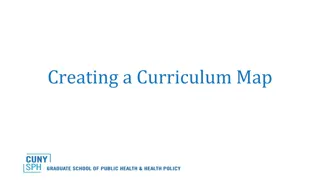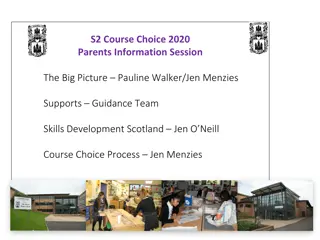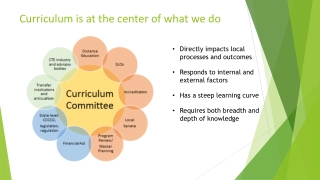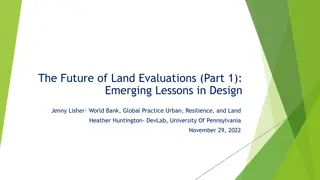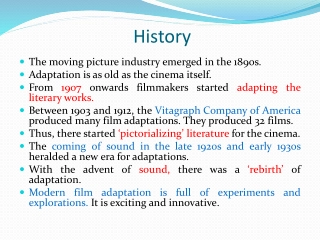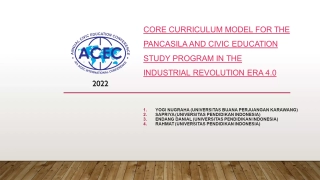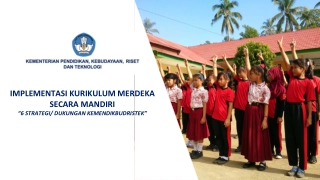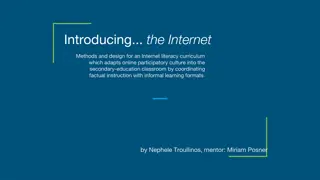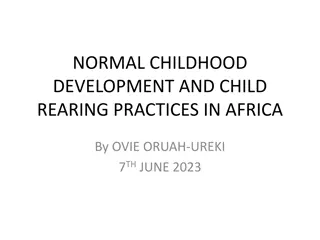Understanding Contextual Factors in Curriculum Development
This chapter delves into the significance of internal and external contextual factors in shaping curriculum development. It discusses the process of gathering essential contextual data, identifying relevant sources, and integrating data to create an evidence-informed, context-relevant, unified curriculum. Key questions addressed include the influence of contextual factors on curriculum, determining essential data, and integrating core curriculum processes. Internal contextual factors such as mission, vision, philosophy, goals, and organizational culture are highlighted to emphasize their role in curriculum development.
Download Presentation

Please find below an Image/Link to download the presentation.
The content on the website is provided AS IS for your information and personal use only. It may not be sold, licensed, or shared on other websites without obtaining consent from the author. Download presentation by click this link. If you encounter any issues during the download, it is possible that the publisher has removed the file from their server.
E N D
Presentation Transcript
Chapter 8 Data Gathering for an Evidence- Informed, Context-Relevant, Unified Curriculum
Questions Addressed in This Chapter What are the internal and external contextual factors that influence curriculum? How are essential contextual data determined? How can relevant data sources be identified, and contextual data gathered?
Questions Addressed in This Chapter What is the relationship between data gathering about contextual factors and an evidence-informed, context-relevant, unified curriculum? How are the core curriculum processes of faculty development, ongoing appraisal, and scholarship integrated into data gathering for curriculum development?
Overview of Contextual Factors, and Gathering and Interpreting Contextual Data Contextual factors Include internal and external factors Some factors may blend and overlap Need precise definition of essential data relevant to each contextual factor Data gathering and interpretation Deduced from contextual data Used to describe desired traits of graduates
Internal Contextual Factors Mission, vision, philosophy, and goals Mission Succinct statement Captures the institution s character Shapes multiple aspects of the school of nursing Nature Scope Boundaries of the mission Activities Curricula
Internal Contextual Factors (cont.) Mission, vision, philosophy, and goals (cont.) Vision Mental image of what organization will achieve when accomplishing mission Philosophy Clearly articulated guiding principles Strategic goals and plans Directly reflect school s mission, vision, purpose, and values
Internal Contextual Factors (cont.) Organizational culture and climate Culture An organization s way of being Unlikely to be explicitly stated Affects whole organization
Internal Contextual Factors (cont.) Organizational culture and climate (cont.) Organizational climate Represents a manifestation of culture Includes shared perceptions and attached meanings Policies and procedures experienced by employees and others Observations of behaviors that are rewarded, supported, and expected Culture and climate evolve slowly over time
Internal Contextual Factors (cont.) History Reveals past values, successes, challenges and curriculum development processes Relevant questions to consider When was institution founded, and why? Has mission, vision, purposes changed over time? How does school s history influence present? How have programs evolved? Were programs developed for niche market? What are school s unique features, programs?
Internal Contextual Factors (cont.) Financial resources Can be most influential contextual factor Focus on costs created by redesigned curriculum Programs and policies Programs will influence curriculum design Non-nursing departmental programs/courses May be asset to curriculum designers May limit the scope of the nursing curriculum proposal
Internal Contextual Factors (cont.) Infrastructure Human, physical, and organizational elements Forms structure of the institution and school of nursing Serves as foundation of educational programs
Internal Contextual Factors (cont.) Infrastructure (cont.) Components: Human Resources Form the core of the curriculum Includes faculty members, students, stakeholders, support staff Physical Resources Includes space for classrooms, offices, laboratories, etc. Resources to support teaching and learning Includes libraries, faculty development services, student services, etc.
External Contextual Factors Demographics Study of human populations Includes size, density, location, age, sex, race, occupation, etc. Demographic data Can influence healthcare delivery Can be used to align curriculum design with attributes of nursing care recipients
External Contextual Factors (cont.) Demographic data pertinent to curriculum work Distribution according to age, sex, and location Birth, death, and fertility rates Population diversity Employment rates and income levels by age and sex Ethnicity Residence patterns (e.g., living alone, homeless, in nursing homes) Morbidity rates and patterns Family structures Population mobility Immigration and emigration patterns
External Contextual Factors (cont.) Culture, Ethnicity, Language, and History Culture Way of life of a people Includes multiple considerations Attitudes Values Beliefs Arts Sciences Modes of perception Habits of thought and activity
External Contextual Factors (cont.) Culture, Ethnicity, Language, and History Culture (cont.) Intimately tied to other characteristics Ethnicity, national group history, language Race and ethnicity May or may not be equated with a particular culture Culture of the healthcare system Includes entitlement to health services, etc. Respect for community culture Prerequisite when designing curriculum
External Contextual Factors (cont.) Health and health care Health of people Influences nursing care Influences curriculum Healthcare system Shapes learning context for the student s professional practice Data collection by curriculum developers Settings/opportunities for learning experiences Current about healthcare delivery patterns
External Contextual Factors (cont.) Professional standards and trends Trends and requirements Includes numerous current standards Health care Nursing practice Nursing education Serve as strong influences on curriculum
External Contextual Factors (cont.) Educational and healthcare technology and informatics Technological advances affect nursing curricula Content Teaching-learning strategies Course delivery Course management Gather relevant technology and informatics data Education, healthcare, and expected developments
External Contextual Factors (cont.) Environment Atmospheric, physical, biological, and psychological aspects of a community Include relevant data Weather patterns and effects of climate change Air and water quality Local industries known to produce pollutants Environmental disasters War and terrorism Newly emerging diseases and their spread
External Contextual Factors (cont.) Social, political, and economic conditions Forces, situations, or circumstances in the external environment Can impact curriculum development Social behaviors, and issues that affect health E.g., drug use or unemployment Political, legislative influences E.g., support for nursing and nursing education Economic conditions, and projected government and private support for higher education
Approaches to Gathering Contextual Data Data gathering Includes activities of obtaining information for curriculum development purposes Planning for data gathering Preliminary requirements Agreement about relevant contextual factors requiring investigation Identification of relevant data, data sources, and methods of obtaining information
Approaches to Gathering Contextual Data (cont.) Deciding on necessary contextual data and data sources Which factors seem most germane? What are the precise data required? Potential utility of data for development process? Which data truly influence curriculum? What data is nice to know? How does data influence curriculum?
Approaches to Gathering Contextual Data (cont.) Deciding on necessary contextual data and data sources (cont.) How accessible and available are the data? How quickly can data be gathered? Is acquisition of data so important that a delay in development can be justified? What are consequences of failing to gather data?
Approaches to Gathering Contextual Data (cont.) Data gathering methods Important considerations Time available for data gathering in plan Time needed to locate extant documents, develop interview questions, gather and analyze data Developer expertise available related to data gathering and analysis Resources to support the endeavor
Approaches to Gathering Contextual Data (cont.) Data gathering methods (cont.) Methods Literature and internet surveys Document and website reviews Key informant interviews Focus group interviews Surveys Delphi technique Consultations
Approaches to Gathering Contextual Data (cont.) The work of data gathering May be given to a specific task force May be shared among curriculum developers Process recommendations Maintain central repository Allows accessibility of data for subsequent analysis Use methods that will speed analysis E.g., immediate computer entry of returned questionnaire responses by an administrative or research assistant, or use of web-based questionnaires
Relationship of Gathering Contextual Data to an Evidence-Informed, Context- Relevant, Unified Curriculum Characteristics of an evidence-informed curriculum Based on systematically and purposefully gathered evidence Students, learning, teaching, and nursing education Clients and their responses to health situation Nursing practice Context in which curriculum will be offered Context in which graduates will practice nursing
Relationship of Gathering Contextual Data to an Evidence-Informed, Context- Relevant, Unified Curriculum (cont.) Characteristics of a context-relevant curriculum Responsive to students, current and projected societal, health, and community situations, and imperatives of nursing profession Consistent with mission, philosophy, goals of the educational institution, and school of nursing Feasible within realities of school and community
Relationship of Gathering Contextual Data to an Evidence-Informed, Context- Relevant, Unified Curriculum (cont.) Characteristics of a unified curriculum Curricular components are interrelated Conceptually Logically Cohesively Visibly
Core Processes of Curriculum Work Faculty development Expand members appreciation and knowledge Emphasize relationship between contextual factors and development of evidence-informed, context- relevant, unified curriculum Ongoing appraisal Includes consideration of numerous questions throughout the data gathering process Scholarship Many opportunities related to gathering data















